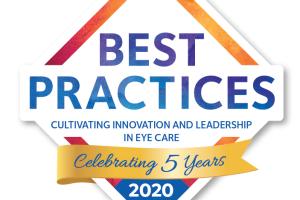Fitting contact lenses is a fundamental part of most eye care practices, offering significant opportunity to make a difference in the lives of patients. And for eye care professionals who successfully leverage all of the available options to find the right lens for each patient, contact lenses can help build their businesses.
Two optometrists from CooperVision’s 2020 Best Practices - Dave Anderson, OD of Miamisburg Vision Care in Miamisburg, Ohio and Lee Ann Hoven, OD of Advanced EyeCare in Durango, Colorado - share their approaches to contact lenses in their practices, and how they have addressed the related challenges—and opportunities—brought on by the COVID-19 pandemic.
Not all practices fit contact lenses. Why do you choose to do so?
Hoven: We see value in providing our patients with alternatives to glasses. Many patients have life circumstances—whether sports, work environment, lifestyle, or quality of vision—wherein contact lenses are the best choice for them.
Anderson: I truly love to provide options for every patient. As optometrists, I believe it is our duty to help our patients not only in diagnosing problems, but in providing a multitude of solutions. We have the opportunity to play a big part in not only helping people see but improving quality of life. I see every patient as a candidate for contact lenses, because with the proper lens choices and expectations, nearly everyone has the potential to wear them.
What is the role of dual wear—glasses and contact lenses—for patients? Is this growing?
Anderson: Even those patients who routinely wear glasses may have portions of their day-to-day lives that may be best suited for contact lenses. As an example, I just recently saw a patient who was a contact lens wearer years ago but dropped out because he is presbyopic and had trouble with multifocals. Due to his work with a microscope, monovision was not an option. He is an avid traveler and was also complaining about his glasses fogging with mask wear due to COVID-19. I asked him to reconsider part-time contact lens wear, and he was happy I brought it up. Right now, I do see increased opportunity to help patients see the benefits of contact lenses, particularly with mask wear—they want to enjoy their activities without the inconvenience of fogging up.
Hoven: I think it’s important to show patients why they should have both glasses and contact lenses. Patients often think it’s an either/or situation; they don’t know they can choose based on which is best for certain circumstances. Some patients have just worn glasses all of their lives and if they wear bifocals, they think it’s too late to try contacts. I personally wear multifocal contact lenses and see a lot of benefits to them, so I love to get patients into them, even if it’s just for when they’re hiking on the weekends. Daily disposable lenses give them that option.
How have you adapted your approach to contact lenses due to the COVID-19 pandemic?
Anderson: I have always been a strong proponent for 1-day contact lenses, and COVID-19 has given me another proof point in that discussion, since they are the healthiest1 option available. But my approach has always been simple; I say to patients, “Let’s not complicate your life to wear contact lenses. Let’s not worry about solutions, the cleaning regimen, or remembering how often to replace.” I always prescribe 1-day lenses first, and if they object to the cost, I’ll move to an alternative.
Hoven: We have an eye on education—teaching how to properly clean and care for contact lenses. It’s always surprising how many patients don’t realize they actually need to change their lenses when they’re supposed to. Or how many don’t truly know how to care for their cases, or to change the solution. We are making sure to reinforce the message that as long as patients are cleaning and changing their lenses like they’re supposed to, they are less likely to run into potential problems.
Have you done anything in particular to maintain or even grow contact lens sales during this time?
Hoven: Through this experience, a lot of our patients learned that it’s not a good idea to put off their contact lens exams and orders. In March and April, many were panicked about getting more lenses. Now that we’ve reopened, we’re seeing less patients per day in order to comply with social distancing guidelines, which gives us more time to have discussions about the benefits of annual supplies—the discounts, rebates, and the fact they’ll be set with lenses for a while. As a result, we have certainly seen growth in the number of annual supply purchases.
Anderson: For patients who don’t purchase annual supplies, we offer the ability to order online through our website. We have definitely seen an uptick in that area of our business. We’re making sure to promote this via e-mail blasts, social media, and of course, speaking directly to patients about it when they’re in our office.
5 Tips for Building a Successful Contact Lens Practice
Find out what patients want from contact lenses.
In the past, there weren’t as many contact lens options as there are today. It’s easier than ever to find a contact lens that fits a patient’s particular needs. Dive deeper into each patient’s history (or lack thereof) with contact lenses, and what they hope to gain from wearing them.
Encourage lens trial.
Particularly with 1-day contact lenses—once a patient tries them and experiences the benefits2 firsthand, they tend to think the extra cost is worthwhile.
Expand offerings to include multifocal, hybrid, and scleral lenses.
Invest in your practice by taking the time to learn about the different options, how to fit them, and be good at it. Train your staff to support you in this area. Being able to successfully fit patients in these lenses can be a game-changer for your practice.
Have a plan B.
Go into each contact lens fitting with more than one lens option. Or if you’re limited due to a patient’s particular prescription, make sure you set expectations up front.
Don’t wait for a patient to ask for contact lenses.
Unless they are medically contraindicated, contact lenses should be an option for every patient. Always have the discussion with your patients, even if they aren’t ready at that point in time. Each time you bring it up, you’re setting the stage for the future.
For more information about CooperVision’s Best Practices, its honorees (current and past), and updates on how they are working to support and advance the profession, visit www.eyecarebestpractices.com.
Versus resuable soft CLs (2-week or monthly replacement). REF: Chalmers RL, Hickson-Curran SB, et all. Rates of adverse events with hydrogel and silicone hydrogel daily lenses in a large postmarket surveillance registry: the TEMPO registry. Invest Ophthalmol Vis Sci 2015; 56: 654-663.
ECP Perceptions of the Benefits of 1-Day Silicone Hydrogels. Survey results of n=100 ECPs in US. February 2018. Cello Health Insight. Data on file.








